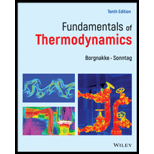
Fundamentals Of Thermodynamics
10th Edition
ISBN: 9781119494966
Author: Borgnakke, C. (claus), Sonntag, Richard Edwin, Author.
Publisher: Wiley,
expand_more
expand_more
format_list_bulleted
Question
error_outline
This textbook solution is under construction.
Students have asked these similar questions
b. The discharge pressure of an air compressor is 6 times the suction pressure. If the volumeflow rate at the suction is 0.86 cubic meters per second, what is the compressor power (kW)for n = 1.38 and suction pressure is 101 kPaa?
An angle from stagnation point is higher for
How can we calculate pressure drop through a baghouse at a given gas flow rate?
Knowledge Booster
Learn more about
Need a deep-dive on the concept behind this application? Look no further. Learn more about this topic, mechanical-engineering and related others by exploring similar questions and additional content below.Similar questions
- i. A wind turbine has the following data: Downstream wind velocity = 9 m/s Upstream wind velocity =18 m/s Rotor Power output = 1 MW a. Compute the wind rotor efficiency. b. Calculate power in the wind and the length of the rotor blades ii. ComparethedifferenttypesBiogasplants?arrow_forward1.) A hand pump is used to inflate a bicycle tire to a gauge pressure of 70 psi. a) How much work must be done if each stroke of the pump is an adiabatic process and what is the final temperature of the gas? b) We inflate the tire in two steps: (i) an isobaric compression and (ii) an isochoric increase in temperature. Calculate the work done by gas/"us" and/or heat added/removed during the two steps! Is this a viable alternative to the adiabtic compression Explain! Atmospheric pressure is 1 atm, the air temperature is initially 25° C, and the volume of the air in the tire remains constant. Useful values: A bicycle tire is 26 in diameter and has a cross-sectional area of 2 in² [1 in = 2.54 cm]. 1 lb corresponds to a mass of 0.445 kg. c) For Take-Home only Solve the questions in a) and b) in terms of the initial pressure P₁ = P*, the final volume Vf = V* and the pressure ratio K = Pf/P*!arrow_forwardQ2: Use dinensional analysis to derive as epresion for the power develaped by an engine in terms of the torpue T and roarive sped u.arrow_forward
- Fast.arrow_forwardThe question is important, Answer it correctly. 1. A ventilation fan is moving 3,200 cfm with a fan static pressure of 8.30" wg. The airflow is increased to 3,500 cfm by increasing the fan speed. What is the new static pressure of the fan?arrow_forwardMust answer all the four questions. Otherwise i will dislike it.arrow_forward
- For a pumper truck pumping water to a fire, the back pressure is the additional pressure on the pump caused by the height of the nozzle. (Another way of thinking of back pressure is as the minimum pressure the pumper must produce in order to make water flow out the end of the nozzle.) Consider a pumper at street level pumping water through a hose to firefighters on the top of the ninth floor of a building. If each floor is 16 feet high, what is the head of water at the mouth of the nozzle?arrow_forwardProblem 1 Given: Find: A 5 ft' tank is initially evacuated (total vacuum). A leak develops and air enters the tank at a constant rate of 0.004 lbm/s. The air is at 70 "F and behaves as an ideal gas. The pressure (lb/in) in the tank 30 seconds after the tank starts leaking.arrow_forwardi need correct explanation my best wishes tonarrow_forward
- A boiler feed pump operates at 40oC suction. If pump efficiency is 85% and needs 20 kW power of motor needed to drive the pump, find the maximum pressure of the boiler could attain for a mass of 2 kg/s.arrow_forwardA pump discharge at 60 ft at 1400 rpm. Pump is at 75% efficiency. What will be discharge at 1000 rpmarrow_forward1) Carbon dioxide, as a gas, at 335 K is pumped at a very high pressure into an oil-well. If CO₂ has a specific gravity of 0.367, then, calculate the gauge pressure at which CO₂ is pumped.arrow_forward
arrow_back_ios
SEE MORE QUESTIONS
arrow_forward_ios
Recommended textbooks for you
 Elements Of ElectromagneticsMechanical EngineeringISBN:9780190698614Author:Sadiku, Matthew N. O.Publisher:Oxford University Press
Elements Of ElectromagneticsMechanical EngineeringISBN:9780190698614Author:Sadiku, Matthew N. O.Publisher:Oxford University Press Mechanics of Materials (10th Edition)Mechanical EngineeringISBN:9780134319650Author:Russell C. HibbelerPublisher:PEARSON
Mechanics of Materials (10th Edition)Mechanical EngineeringISBN:9780134319650Author:Russell C. HibbelerPublisher:PEARSON Thermodynamics: An Engineering ApproachMechanical EngineeringISBN:9781259822674Author:Yunus A. Cengel Dr., Michael A. BolesPublisher:McGraw-Hill Education
Thermodynamics: An Engineering ApproachMechanical EngineeringISBN:9781259822674Author:Yunus A. Cengel Dr., Michael A. BolesPublisher:McGraw-Hill Education Control Systems EngineeringMechanical EngineeringISBN:9781118170519Author:Norman S. NisePublisher:WILEY
Control Systems EngineeringMechanical EngineeringISBN:9781118170519Author:Norman S. NisePublisher:WILEY Mechanics of Materials (MindTap Course List)Mechanical EngineeringISBN:9781337093347Author:Barry J. Goodno, James M. GerePublisher:Cengage Learning
Mechanics of Materials (MindTap Course List)Mechanical EngineeringISBN:9781337093347Author:Barry J. Goodno, James M. GerePublisher:Cengage Learning Engineering Mechanics: StaticsMechanical EngineeringISBN:9781118807330Author:James L. Meriam, L. G. Kraige, J. N. BoltonPublisher:WILEY
Engineering Mechanics: StaticsMechanical EngineeringISBN:9781118807330Author:James L. Meriam, L. G. Kraige, J. N. BoltonPublisher:WILEY

Elements Of Electromagnetics
Mechanical Engineering
ISBN:9780190698614
Author:Sadiku, Matthew N. O.
Publisher:Oxford University Press

Mechanics of Materials (10th Edition)
Mechanical Engineering
ISBN:9780134319650
Author:Russell C. Hibbeler
Publisher:PEARSON

Thermodynamics: An Engineering Approach
Mechanical Engineering
ISBN:9781259822674
Author:Yunus A. Cengel Dr., Michael A. Boles
Publisher:McGraw-Hill Education

Control Systems Engineering
Mechanical Engineering
ISBN:9781118170519
Author:Norman S. Nise
Publisher:WILEY

Mechanics of Materials (MindTap Course List)
Mechanical Engineering
ISBN:9781337093347
Author:Barry J. Goodno, James M. Gere
Publisher:Cengage Learning

Engineering Mechanics: Statics
Mechanical Engineering
ISBN:9781118807330
Author:James L. Meriam, L. G. Kraige, J. N. Bolton
Publisher:WILEY
Power Plant Explained | Working Principles; Author: RealPars;https://www.youtube.com/watch?v=HGVDu1z5YQ8;License: Standard YouTube License, CC-BY